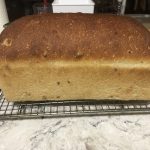
Sunflower Seed Bread
I learned about this at a grocery store bakery and loved it there. They mixed this bread daily and I knew I had to adapt it to my own needs. This is what I came up with. It is a good sandwich bread, can be baked as a round or rolls, but I like the loaf. It toasts so nicely and makes excellent grilled cheese sandwiches.
Ingredients
Sunflower seed bread
- 20 oz Bread flour
- 14 oz Room temperature water
- .5 oz Salt
- 10 g Instant yeast a generous T of instant yeast
- 60 g Sunflower seeds, roasted unsalted 2.1 oz
Starter
- 2 oz Bread flour
- 2 oz Room temperature water
- pinch Instant yeast Optional
Instructions
Mix the starter
-
With a wooden spoon in a stainless steel bowl, stir the flour, water and yeast together. Stir vigorously until you see the starter develop strands in the bowl. Scrape the starter all down onto itself, cover and leave on the counter overnight.
Mix the bread
-
Place all the starter and water into the mixing bowl of your stand mixer.
Measure the flour into a separate bowl. Add the yeast on the left side of the pile of flour and the salt on the right side of the flour.
Measure the sunflower seeds into another bowl.
-
Add the flour, salt and yeast to the water/starter and mix on low with the dough hook for 3 minutes.
Raise the speed to medium and mix another 3 minutes.
-
The dough should look like dough. It should have cleaned the sides and bottom of the bowl, have a smooth feel and not be sticky. It is expected that a dough will be tacky to the touch.
-
Add the sunflower seeds and mix on low until they are incorporated. You may need to stop the mixer, remove the dough from the dough hook, flip it top to bottom and mix some more to ensure a good distribution of seeds.
-
Remove the dough to the counter. Gently work the dough into a large ball, pinching with the palm of your hand the dough to a central point. Place that in to a buttered bowl, seem side down and cover with plastic wrap for 35 minutes.
-
After 35 minutes, the dough will have increased in size. Turn the dough over and gently pull the dough at the 4 points of the clock, 12, 3, 6, 9 up and to the center. Turn the dough over again, cover and let rest another 35 minutes.
Shape the bread
-
Portion the dough to 1 kilo, 2.2 lbs, and shape into a round. Allow to rest on the counter, with a bit of flour underneath and on top of the dough. Cover with plastic wrap to keep the dough from drying out.
While the rests, butter or spray a loaf pan. My bread pan is approximately 5 inches by 10 inches and 2.5 inches deep. If you have smaller pans, you may need to adjust your dough sizes and make two smaller loaves.
Heat your oven to 375 degrees
-
To shape the dough for the loaf pan, turn the dough over onto a lightly floured counter and press it into an oval-ish rectangle. Fold the top half of the dough toward you as if folding a letter and press that seam with the heal of your hand. Be firm enough to actually seal the dough, but not so firm as to push through to the counter. Turn the dough around so the end nearest you is now the top. Repeat the letter fold and press.
-
Lift the bottom of the away side of the dough and bring it toward you to fold it in half and let the edges meet. The dough is a bit big and in the way so this can be challenging, but use the heal of your hand again and push the seal tight. This time you can press a bit more vigorously.
-
Roll the dough on the counter if it is not as wide as the pan. Place the dough seam side down and place in a table top proofer. If you don't have one, lightly dust the top of the dough with flour and press plastic wrap on to the pan or lay a tea towel over the pan. Allow to proof until the dough rises above the edge of the pan and a finger gently pressed into the top of the dough leave a small indent.
-
If you wish, you may slice the length of the dough once with a serrated blade or a razor, or you may leave the bread as is. Place in the center of the over and bake for 35 minutes, rotating the pan once half at 17 minutes to allow for even baking and browning of the top.
-
Bread is done when it makes a hollow thumping sound when tapped on the bottom. That's a skill to learn, but bread is also done at 180 degrees. Sneak an instant read thermometer into the bread just above the pan in the center side and aim for the middle of the bread. If the thermometer reads 180 degrees, the bread is done.
-
Remove the pan to a cooling rack and let the dough stand 5 minutes.
-
With hotbeds, gently loosen and remove the bread to the cooling rack, laying the bread in its side as it cools.
-
An aspect of baking many people aren't taught is the cool down part. Baking also includes the chemical reactions of starch gelatinization, sugar caramelization and protein coagulation resting. Proper cooling of bread is as crucial as the mixing and baking. Cutting the bread too soon terminates that process and the bread suffers. Yes, I know just how amazing hot bread is.